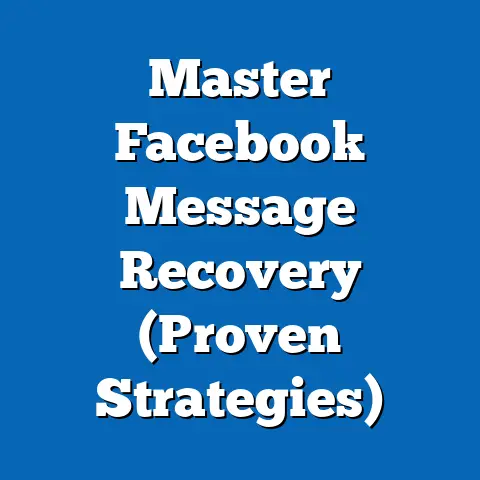Reclaim Ads: Activate a Disabled Facebook Account (Pro Tips)
I’ll never forget the day I logged into Facebook Ads Manager and saw that dreaded red notification: “Ad account disabled.” My heart sank. It felt like all the hard work I’d put into building my online presence and reaching my audience had been pulled out from under me. Panic set in – how would I continue to run my business without Facebook ads?
Facebook advertising is a crucial component of modern digital marketing. For many businesses, like mine, it’s the lifeblood of lead generation, brand awareness, and sales. When your ad account is disabled, it can feel like your entire marketing strategy is on hold. It’s a frustrating and stressful experience, to say the least.
But don’t despair! I’m here to tell you that reclaiming your ads and reactivating your Facebook ad account is often possible. Over the years, I’ve learned a thing or two about navigating the often-opaque world of Facebook’s advertising policies. In this guide, I’ll share my pro tips and hard-earned wisdom to help you successfully reactivate your account and get back to running profitable campaigns. I’ll walk you through the steps, share some personal experiences, and arm you with the knowledge you need to prevent this from happening again.
Understanding Why Accounts Get Disabled
Before diving into the reactivation process, it’s essential to understand why Facebook disables ad accounts in the first place. While it can feel arbitrary at times, there are usually underlying reasons related to policy violations, suspicious activity, or payment issues.
Here are some of the most common reasons:
-
Policy Violations: This is the big one. Facebook has a comprehensive set of advertising policies that cover everything from prohibited content (hate speech, misinformation, etc.) to restricted content (alcohol, gambling, etc.) and required disclosures (health and financial products). Even unintentional violations can lead to account disablement.
-
Suspicious Activity: If Facebook detects unusual login attempts, suspicious payment activity, or a sudden spike in ad spend, it might flag your account as compromised and disable it to protect you (and them).
-
Payment Issues: Failed payments, expired credit cards, or discrepancies in billing information can also trigger account disablement.
-
Poor Ad Quality: Ads with low engagement rates, misleading content, or excessive negative feedback can negatively impact Facebook’s user experience and lead to penalties.
-
Circumventing Systems: Trying to bypass Facebook’s ad review process or using cloaking techniques to show different content to Facebook’s bots than to users is a surefire way to get your account disabled.
Policy Violations: This is the big one. Facebook has a comprehensive set of advertising policies that cover everything from prohibited content (hate speech, misinformation, etc.) to restricted content (alcohol, gambling, etc.) and required disclosures (health and financial products). Even unintentional violations can lead to account disablement.
Suspicious Activity: If Facebook detects unusual login attempts, suspicious payment activity, or a sudden spike in ad spend, it might flag your account as compromised and disable it to protect you (and them).
Payment Issues: Failed payments, expired credit cards, or discrepancies in billing information can also trigger account disablement.
Poor Ad Quality: Ads with low engagement rates, misleading content, or excessive negative feedback can negatively impact Facebook’s user experience and lead to penalties.
Circumventing Systems: Trying to bypass Facebook’s ad review process or using cloaking techniques to show different content to Facebook’s bots than to users is a surefire way to get your account disabled.
According to industry studies, a significant percentage of Facebook advertisers experience account disablement at some point. It’s more common than you might think. I remember a friend of mine, Sarah, who runs a small e-commerce business, had her account disabled because she accidentally used a stock photo in her ad that violated Facebook’s copyright policy. It was a minor oversight, but it had a significant impact on her sales for several days. This really hammered home for me how important it is to be vigilant and stay on top of Facebook’s ever-changing rules.
Takeaway: Understanding the common reasons for account disablement is the first step in preventing it and preparing for a successful reactivation if it happens.
The Emotional Toll of Account Disablement
Let’s be honest, having your Facebook ad account disabled is more than just a technical inconvenience. It’s an emotional rollercoaster. The initial shock and disbelief quickly give way to stress, anxiety, and a desperate urge to fix the situation immediately.
I remember when my account was disabled, I felt a wave of panic wash over me. I was launching a new product, and my entire marketing campaign was riding on Facebook ads. I felt like I was letting my team down, and I was worried about the financial impact on my business.
The feeling of helplessness is real. You’re at the mercy of Facebook’s support team, and it can feel like you’re shouting into the void. The waiting game is excruciating, and the uncertainty can be crippling.
It’s important to acknowledge these emotions and give yourself permission to feel them. However, it’s equally important to stay calm and collected. A positive mindset can significantly contribute to a successful resolution. Remember, many advertisers have been in your shoes, and most accounts can be reactivated with the right approach.
Takeaway: Acknowledge the emotional impact of account disablement, but maintain a calm and positive mindset to navigate the reactivation process effectively.
Step-by-Step Guide to Reactivating Your Facebook Ad Account
Now, let’s get down to the nitty-gritty. Here’s a step-by-step guide to reactivating your Facebook ad account:
Step 1: Review Facebook’s Ad Policies
Before you do anything else, take a deep breath and thoroughly review Facebook’s advertising policies. I know it sounds tedious, but it’s crucial to understand the rules of the game. Facebook’s policies are extensive and cover a wide range of topics, so it’s easy to miss something.
- Where to Find the Policies: You can find the official Facebook advertising policies in the Meta Business Help Center. Just search for “Facebook Advertising Policies.”
- Focus on the Specifics: Pay close attention to the sections that are most relevant to your business and the types of ads you run. For example, if you’re in the health and wellness industry, carefully review the policies related to health claims and endorsements.
- Look for Updates: Facebook frequently updates its policies, so make sure you’re reviewing the latest version.
I once made the mistake of assuming I knew the policies inside and out. I was promoting a weight loss product, and I used a before-and-after photo in my ad. I thought it was harmless, but Facebook flagged it as violating their policy against making unrealistic or exaggerated claims. I had to learn the hard way that even seemingly innocuous content can trigger a violation.
Takeaway: Thoroughly reviewing Facebook’s advertising policies is essential for understanding the rules and preventing future violations.
Step 2: Accessing Your Account Quality Dashboard
The Account Quality dashboard is your go-to resource for understanding why your account was disabled and what actions you can take.
- How to Access: You can access the Account Quality dashboard through your Business Manager. Look for the “Account Quality” option in the left-hand menu.
- What to Look For: The dashboard will show you a summary of your account status, including any violations or restrictions. It will also provide details about the specific reasons for the disablement.
- Identify the Issue: Carefully review the information in the dashboard to pinpoint the exact policy violation or issue that led to the disablement. This is crucial for preparing your appeal.
I remember when I first accessed the Account Quality dashboard after my account was disabled, I was overwhelmed by the amount of information. It took me a while to understand the different sections and figure out what I needed to focus on. But once I identified the specific policy violation, I was able to start building my case for the appeal.
Takeaway: The Account Quality dashboard provides valuable insights into the reasons for account disablement and is the starting point for the reactivation process.
Step 3: Prepare Your Appeal
Your appeal is your opportunity to explain your situation to Facebook and convince them to reactivate your account. It’s crucial to be clear, concise, and professional in your communication.
- Acknowledge the Issue: Start by acknowledging the policy violation or issue that led to the disablement. Show that you understand the problem and take responsibility for it.
- Explain the Situation: Provide a clear and concise explanation of how the issue occurred. Be honest and transparent. If it was an unintentional mistake, explain the circumstances.
- Outline Corrective Actions: Detail the steps you’ve taken to correct the issue and prevent it from happening again. This is crucial for demonstrating that you’re serious about complying with Facebook’s policies.
- Express Commitment to Compliance: Reiterate your commitment to following Facebook’s advertising policies in the future.
- Keep it Concise: While it’s important to be thorough, avoid rambling or providing irrelevant information. Keep your appeal focused and to the point.
I spent hours crafting my appeal after my account was disabled. I made sure to address each point in the policy violation and explain the steps I had taken to prevent it from happening again. I also included screenshots and other supporting documentation to bolster my case. It was a lot of work, but it paid off in the end.
Takeaway: A well-prepared appeal is essential for convincing Facebook to reactivate your account. Be clear, concise, and professional in your communication, and demonstrate your commitment to compliance.
Step 4: Submitting the Appeal
Once you’ve prepared your appeal, it’s time to submit it through Facebook’s platform.
- Where to Submit: You can submit your appeal directly through the Account Quality dashboard. Look for the “Request Review” or “Appeal” button next to the specific violation.
- Provide Supporting Documentation: Be sure to include any supporting documentation that strengthens your case, such as screenshots, invoices, or policy clarifications.
- Be Patient: After submitting your appeal, it can take several days or even weeks for Facebook to review it. Be patient and avoid submitting multiple appeals, as this can slow down the process.
I remember feeling anxious and impatient after submitting my appeal. I kept checking the Account Quality dashboard every few hours, hoping to see a response. It was a nerve-wracking experience, but I knew I had to be patient and trust the process.
Takeaway: Submit your appeal through the Account Quality dashboard and provide any supporting documentation. Be patient and avoid submitting multiple appeals.
Step 5: Follow-Up and Monitoring
After submitting your appeal, it’s important to follow up and monitor the status of your request.
- Check the Account Quality Dashboard: Regularly check the Account Quality dashboard for updates on your appeal. Facebook will usually notify you of their decision through the dashboard.
- Contact Support: If you haven’t received a response within a reasonable timeframe (e.g., a week or two), you can try contacting Facebook’s support team through the Business Help Center. However, be polite and respectful in your communication.
- Be Prepared for Rejection: Unfortunately, not all appeals are successful. If your appeal is rejected, don’t give up. Review the reasons for the rejection and try to address them in a new appeal. You can also try contacting Facebook’s support team for further clarification.
I was ecstatic when I finally received the notification that my account had been reactivated. It felt like a huge weight had been lifted off my shoulders. I immediately logged in and started reviewing my campaigns to make sure everything was running smoothly.
Takeaway: Follow up and monitor the status of your appeal. Be prepared for rejection and don’t give up if your initial appeal is unsuccessful.
Pro Tips for Preventing Future Account Disablement
Prevention is always better than cure. Here are some pro tips based on my experiences and observations to help you avoid future account disablement:
- Stay Compliant: Continuously monitor your ads and ensure they comply with Facebook’s advertising policies.
- Regularly Review Performance: Keep an eye on your ad performance and account status. Address any issues promptly.
- Engage with Support: Proactively engage with Facebook’s support channels if you have questions or concerns.
- Use High-Quality Visuals: Avoid using stock photos or visuals that might violate copyright policies.
- Be Transparent: Be transparent about your products and services in your ads. Avoid making misleading or exaggerated claims.
- Secure Your Account: Protect your account with strong passwords and two-factor authentication.
- Monitor Payment Information: Keep your payment information up to date and monitor your billing activity for any suspicious charges.
I’ve learned these tips the hard way, through trial and error. By implementing these best practices, you can significantly reduce your risk of account disablement and maintain a healthy and profitable advertising presence on Facebook.
Takeaway: Proactive compliance and vigilance are key to preventing future account disablement.
Conclusion
Having your Facebook ad account disabled can be a daunting experience, but it’s often possible to reclaim it with the right approach. By understanding the reasons for account disablement, following the step-by-step guide to reactivation, and implementing preventive measures, you can successfully navigate this challenge and get back to running profitable campaigns.
Remember, persistence and understanding the process are key to successful reactivation. Stay calm, be patient, and don’t give up. With a little effort and the right knowledge, you can reclaim your ads and continue to grow your business on Facebook. Good luck!






